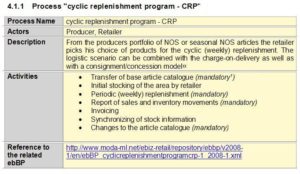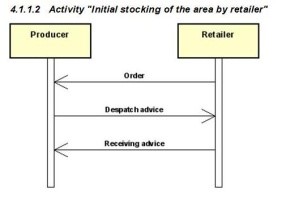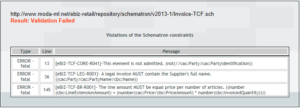OBJECTIVE
The Reference Architecture is a Guide. It is a technical guiding document supported by on-line resources and a compliance-check tool.
The Architecture defines agreed specifications on: Business Models, Business Processes, Data Models, Product Identification and Classification, Communication Protocols.
It is free and available on line. It is used by IT specialists to create new eBusiness connections or to update those already used by fashion companies. Since June 2013, the Architecture is also an official document (CWA) published by CEN, the European Committee for Standardization.
In 2018, after the end of the eBIZ 4.0 project, the new eBIZ 2018 version was released.
CONFORMANCE CRITERIA
There are four main types of elements in the Architecture. The hereafter criteria of conformance indicate what is expected from users who wish to adopt the eBIZ Reference Architecture. The minimal criteria of conformance can be summarised as :
1 - The organisational and procedural aspects of business scenarios
Downstream the architecture specifies the ‘mandatory’ minimum set of transactions of each process; the pilots, once defined the process they are interested in, must implement at least this minum set of transactions.
2 - The semantic and data models to exchange information
Downstream there is also the necessity of a second check using the Use Profiles that presently are not implemented by XSDs for automatic validation (they restrict the basic UBL XSDs specifications).
In both the cases it is mandatory to use versions of the specifications that are not former than those mentioned in the architecture report.
To validate instances of electronic documents (upstream or downstream) an official on-line Validator has been published (click here for more info)
3 - The product and party classification and identification
The only exception could be for ‘local networks’ communications: in this case if the pilots are not able to implement the global identifications in due time, it is acceptable that local network communications use other identification systems (in this case the ‘schemaName’ must be declared explicitly according to the adopted use profiles);
Anyway it must be demonstrated the capability to translate the local identification system towards the global ones before starting to broaden the communication towards other partners.
Upstream any kind of identifier can be accepted for product/part identification (but the issuing organisation must be declared clearly), is a duty of the parties to avoid misunderstandings; the parties and locations usually are explicitly and extensively described.
4 - The middleware and communication protocols
Once it is endorsed by the companies’ management, the eBIZ Reference Architecture is meant to be used by the companies’ usual ICT suppliers or own specialists (if present).
The new eBIZ 2018 version
The new eBIZ 2018 official version of eBIZ specification is based on the results of the eBIZ 4.0 project and on the collection of other further requirements emerged after the release of the last official version, eBIZ 2013.
In this new 2018 version, eBIZ 4.0 project has contributed with a lot of work based on three pilots that explored various aspects of the fashion supply chains (textile, clothing, footwear, etc.) across different countries (Italy, France, Spain, but also Germany, Hungary, Portugal, just to mention some of the involved countries).
Indeed, the eBIZ 4.0 pilots allowed to explore scenarios not yet supported by the specifications (like the “Subcontracted fashion manufacturing” processes) and, at the same time, to discover further requirements for the already supported ones (for example, for better supporting the RFID information in the logistic electronic business documents).
The implemented changes (deeply explained in the public deliverable D4.2) involve all the components of the specification: documents, processes, elements of the vocabulary and code lists; as a result of the huge work done there are two new business processes, 3 new documents, more than 130 terms and 300 updates in the existing terms.
Thanks to the inputs coming from the eBIZ 4.0 pilots, the initial domain of eBIZ specification has been enlarged in order to support scenarios with new players/roles, the Brand and the nth-tier suppliers, and new sale channels like the eCommerce Platforms.
From the content point of view, the main enrichment in eBIZ deal with:
- Fashion subcontracting: master data, commission order and dispatch advice in a multi-tier supply chain
- Improved management of (multiple) serial codes for the products (support to RFID as well as NFC multiple codings)
- Multilingualism and multimedia contents for feeding eServices platforms
- Inclusion of documentation such as certificates as embedded or external elements
- Accessories supplying with the introduction of a color-size matrix to describe the different varieties of articles
- Improved logistic information through packing list information and detailed description of ‘types of packages’ and actual packages lists.
Finally, some of the already available tools have been improved and new Tools are available on-line to browse the set of documents and collaboration processes supported, for example the ATLAS that allow to show documents categorized for function (for example dispatch advice) and for product (for example fabric).
It is important to highlight that the changes to the eBIZ specifications do not compromise its backward compatibility; this ensure the interoperability between systems based on older versions and others adopting the new one.
You can find the technical documentation already online on the technical documentation site.
For more information:
- More details together in the deliverable D4.2 of eBIZ 4.0.
- Complete “Version Change” guides, for each eBIZ document, are available in COMPARE VERSION GUIDEs LIST or by accessing the presentation sheets for each document to the ‘Compare version’ indication.
eBIZ validation tool
The eBIZ validation tool allows user to check compliance with the eBIZ reference architecture
- “eBIZ – Textile/Clothing and Footwear Downstream document Validator”
for data exchange between manufacturers and point of sale - “eBIZ – Textile/Clothing Upstream document Validator”
for data exchange between manufacturers and suppliers in textile/clothing - “eBIZ – Footwear Upstream document Validator”
for data exchange between manufacturers and suppliers in footwear
How to adopt eBIZ?
Before adopting eBIZ you should consider that:
- eBIZ is a reference, thus you have to identify the PROCESS and related activities you are interested in and select the subset to implement;
- the subset of eBIZ you will use and your choices about its use (for example by reducing optional elements) is your Collaboration Use Profile. A good formalization of the profile and a testing strategy before the implementations saves a lot of time and costs at rolling out towards a new business partner;
- eBIZ is addressing only the information exchanges between different applications and does not rule what happens inside the different systems;
- eBIZ is a public and free specification, you and your IT suppliers are free to implement it while remaining conformant;
- implementations might be based on:
- the adaptation of existing applications (for example by adding modules with the functionalities of import/export towards eBIZ XML formats and message sending); this is the most frequent choice because usually the main functionalities are already in place and need small adaptations;
- completely new applications, usually developed to add new internal functionalities and to support eBIZ (for example new planning functionalities);
- the purchase of clearing or SCM services from already established providers, for example when setting up a new SCM portal (in any case a small interface towards the internal system is required).
- a good starting point might be an introductory course on eBIZ (https://www.ebiz.enea.it/eBIZ/imple/pg.asp?lingua=en&p=685)
while the complete list of eBIZ reference processes might be found on the Reference Architecture report or here: https://www.ebiz.enea.it/eBIZ/imple/pg.asp?lingua=en&p=545
Steps towards adoption
| Step | Related images |
| Step 1. Boundaries identification of Domain and Process of application (and involved industrial partners);
Choose, if any, the eBIZ reference process of your interest. They are here: https://www.ebiz.enea.it/ebiz/imple/pg.asp?p=545
|
 |
| Step 2. Transactions Analysis: process implementation (creation of your Use Profile, first part).
For each business process, confirm that the reference process implementation matches the business requirements by verifying them against the described activities.
|
 |
| Step 3. Document Analysis & Mapping for each transaction (creation of your Use Profile, second part): information mapping into the standard document template for each transaction.
|
 |
| Step 4. Choice of your transmission channels and protocols | |
| Step 5. Agreement with the business partners on a Use Profile that describes which part of eBIZ you will use and how. At least some of the business partners should be involved and agree on your approach. | |
| Step 6. Implementation of
Import/export tools and transmission protocols; including conformance testing (automated test also for Use Profiles is recommended) |
 |
| Step 7. Trials with a first group of business partners
(including interoperability testing) |
|
| Final Roll-out |
REFERENCE ARCHITECTURE AT A GLANCE (2018)
Reference processes fitting real industry needs:
reference processes for textile clothing production (upstream)
reference processes for footwear production (upstream)
reference processes for textile clothing and footwear supplying for retailers (upstream)
(from “Yarn subcontracted manufacturing” to “Vendor managed Inventory” process)
A large number of document formats available to transfer information:
business document templates for textile clothing production (upstream)
business document templates for footwear production (upstream)
business document templates for textile clothing and footwear supplying for retailers (upstream)
A LOT OF RESOURCES AVAILABLE for developers
The only Textile Clothing production area (upstream) offers more than 380 resources (XML Schema, XSLT, examples, user guides, code lists, ..)
